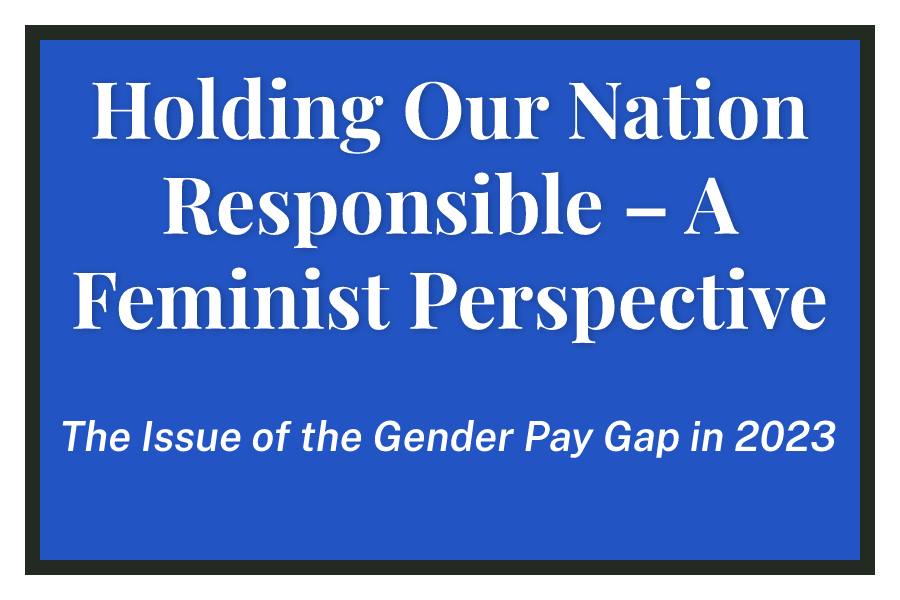Holding Our Nation Responsible – A Feminist Perspective
The Issue of the Gender Pay Gap in 2023
As I sit in Mr. Bigelow’s history class, I usually find myself reflecting on parts of American history, shocked by how much inequality has filled our past. And our daily current events presentations have made me realize that history truly does repeat itself. We’ve seen it about a billion times these past few years: a group is targeted and stripped of rights, then a leader steps in and creates temporary “equality,” just for the cycle to repeat itself once again. In today’s world, it’s hard for me to believe that a discrepancy as awful and outdated as the gender pay gap still exists.
The gender pay gap, defined as the difference in earnings between men and women, has been a persistent issue in the United States and worldwide. While progress has been made over the past few decades in reducing the gap, The National Women’s Law Center found that women in the United States earn only 82 cents for every dollar men earn. And the gap widens for women of color as black women earn only 63 cents and Latina women earn only 55 cents for every dollar white men make. As a whole, this isn’t a “women’s issue;” it affects families, communities, and the economy as a whole.
One of the most significant social changes in recent years has been the changing economic status of women in the United States. Although levels of sex-based segregation have declined, and women have increased their representation in male-dominated fields, the gender pay gap remains prominent. Through my constant digging and researching, I found that no study has systematically proven whether the decline in the earnings gap has taken on different patterns or trajectories in economic sectors. But, on these websites, the blame for the gender pay gap has been placed on occupational segregation. In this article, I’ll focus on the complexities of the gender pay gap, examining what I believe are its causes beyond the idea of occupational segregation.
Why occupational segregation isn’t an explainable cause of the gender pay gap
Most studies I saw split the gender pay gap into two sections: the “explainable causes” and the “unexplainable causes.” We see the typical “explainable” idea of occupational segregation spread across many studies, explaining that women are more likely to work in lower-paying fields because they aren’t as educated as men. However, these studies read like a paradox. The National Center for Education Statistics (NCES) proves that women have surpassed men in overall rates of college graduation and have reached parity with men in rates of earning doctoral and professional degrees. That’s why this argument makes no sense. How can women be in lower-paying fields because of their “lack of education” when their graduation rate is higher?
Sociologists have long argued that occupational segregation is the most significant factor in wage disparities between men and women. In their view, women are self-selected into lower-paying jobs. However, in recent decades, the American Labor Market has tracked the rate of occupational discrimination, noticing the decline of this factor in the United States.
Research has shown that, even in fields dominated by women, such as education and healthcare, men are often paid more than women in the same positions. The National Center for Education Statistics explains that while women make up 76% of public elementary and secondary school teachers, they earn only 80% of what their male counterparts earn. This research proves the term “occupational segregation” is an excuse to continue the gender pay gap, and ignore the root cause: systemic issues of gender discrimination and bias.
Gender Discrimination and Bias
While occupational segregation has historically been viewed as the leading cause of the gender pay gap, recent research shows that gender discrimination and bias are some of the most significant factors contributing to the persistence of the pay gap.
Women still face discrimination in hiring, promotion, and pay, even though such discrimination is illegal. Several studies have found that gender discrimination is widespread, particularly in male-dominated fields, since women are less likely to be hired for jobs. When they are, they face lower pay and fewer opportunities for advancement. A study published in the Journal of Applied Psychology found that men are more likely to be hired regardless of qualifications or experience. Women have to meet higher standards to be considered for the same jobs. Many researchers applied an experimental approach to finding results in this investigation using correspondence testing.
Correspondence testing and its results
Correspondence testing is the research methodology used to investigate discrimination in hiring practices. It involves sending in identical job applications, except for the applicant’s gender, race, or other demographic characteristics, to potential employers to see if discrimination occurs. The researchers can then compare the responses to determine whether the applicant’s demographic factors influenced the employer’s decision-making process. Correspondence testing has become an increasingly popular method of testing for hiring discrimination, particularly in studies focusing on gender bias in the workplace. In recent years, many studies have utilized this method to test for gender bias in hiring processes in various industries, including law, finance, and technology. One notable example is a study conducted by the National Bureau of Economic Research (NBER) in which the researchers used correspondence testing to examine gender discrimination in hiring STEM (science, technology, engineering, and math) faculty. The study involved 872 applications to tenure-track positions at 371 universities in the United States and found that female candidates were rated lower than identically qualified male candidates and were less likely to be offered a job.
The study’s results showed that on a scale of 1 to 5, with five being the highest, male candidates received an average score of 4 for competence, while female candidates received an average score of 3.7. This study proves that systemically-rooted gender bias has significant implications for women, businesses, and the advancement of science and technology, as it limits the diversity of perspectives and experiences that are needed for innovation.
Stereotyping
Stereotyping in the workplace is a pervasive problem that can significantly impact employees’ experiences and opportunities for career advancement. Gender-based stereotyping, in particular, can lead to biased hiring, promotion, and compensation decisions and create a hostile work environment for women. As women who are perceived as emotional or weak may be overlooked for leadership positions or essential projects, women who are stereotyped as incapable of handling high-pressure situations may be unfairly penalized in performance evaluations, limiting their opportunities for career advancement and leading to lower salaries.
Research has consistently shown that gender-based stereotyping is a widespread problem in the workplace. A study by the Pew Research Center found that 43% of working women reported experiencing gender discrimination in the workplace, including being passed over for promotions or opportunities for career advancement. Another study by Catalyst, a non-profit organization focused on advancing women in the workplace, found that women are often stereotyped as less committed to their careers than men and are, therefore, less likely to be considered for high-profile assignments or promotions.
Stereotyping results in hostile work environments for women, as they may constantly feel isolated and unsupported, leading to feelings of anxiety, depression, and burnout, leading to a negative cycle in which women’s performance suffers due to the effects of stereotyping, further reinforcing biased perceptions of women’s abilities. To address gender-based stereotyping in the workplace, it’s essential to implement policies and training programs to address implicit biases and promote gender equality in every workplace. Some companies have implemented unconscious bias training programs to help workers overcome their prejudices and to educate them on the culture of respect and inclusivity. Also, many women workers have established employee resource groups to provide a safe space for open conversation about gender discrimination in the workplace.
Addressing the issue of stereotyping in the workplace requires a collective effort from all members, from top-level management to entry-level employees. By working together to promote gender equality and challenge biased perceptions, we can create a more equitable and just workplace.
Overall, it’s clear that the gender pay gap is not solely a result of occupational segregation, as all the studies say, but rather a deep-seated issue of gender discrimination and bias that has persisted over time. Despite significant progress in women’s rights and gender equality, women face unequal pay and workforce opportunities. Only by acknowledging and addressing these underlying issues of discrimination and bias can we hope to close the gender pay gap and create a more just and equitable society. We must work towards creating a world where all individuals are treated fairly and given equal opportunities to succeed, regardless of their gender or any other aspect of their identity. Only then can we truly achieve gender equality.








